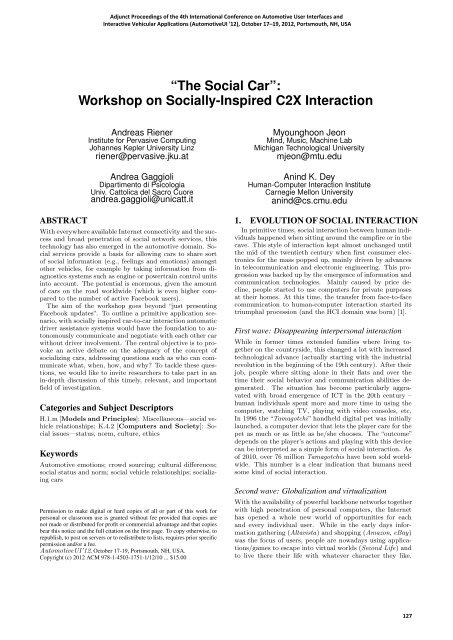12: Adjunct Proceedings - Automotive User Interfaces and ...
12: Adjunct Proceedings - Automotive User Interfaces and ...
12: Adjunct Proceedings - Automotive User Interfaces and ...
Create successful ePaper yourself
Turn your PDF publications into a flip-book with our unique Google optimized e-Paper software.
ABSTRACT<br />
“The Social Car”:<br />
Workshop on Socially-Inspired C2X Interaction<br />
Andreas Riener<br />
Institute for Pervasive Computing<br />
Johannes Kepler University Linz<br />
riener@pervasive.jku.at<br />
Andrea Gaggioli<br />
Dipartimento di Psicologia<br />
Univ. Cattolica del Sacro Cuore<br />
<strong>and</strong>rea.gaggioli@unicatt.it<br />
With everywhere available Internet connectivity <strong>and</strong> the success<br />
<strong>and</strong> broad penetration of social network services, this<br />
technology has also emerged in the automotive domain. Social<br />
services provide a basis for allowing cars to share sort<br />
of social information (e.g., feelings <strong>and</strong> emotions) amongst<br />
other vehicles, for example by taking information from diagnostics<br />
systems such as engine or powertrain control units<br />
into account. The potential is enormous, given the amount<br />
of cars on the road worldwide (which is even higher compared<br />
to the number of active Facebook users).<br />
The aim of the workshop goes beyond “just presenting<br />
Facebook updates”. To outline a primitive application scenario,<br />
with socially inspired car-to-car interaction automatic<br />
driver assistance systems would have the foundation to autonomously<br />
communicate <strong>and</strong> negotiate with each other car<br />
without driver involvement. The central objective is to provoke<br />
an active debate on the adequacy of the concept of<br />
socializing cars, addressing questions such as who can communicate<br />
what, when, how, <strong>and</strong> why? To tackle these questions,<br />
we would like to invite researchers to take part in an<br />
in-depth discussion of this timely, relevant, <strong>and</strong> important<br />
field of investigation.<br />
Categories <strong>and</strong> Subject Descriptors<br />
H.1.m [Models <strong>and</strong> Principles]: Miscellaneous—social vehicle<br />
relationships; K.4.2 [Computers <strong>and</strong> Society]: Social<br />
issues—status, norm, culture, ethics<br />
Keywords<br />
<strong>Adjunct</strong> <strong>Proceedings</strong> of the 4th International Conference on <strong>Automotive</strong> <strong>User</strong> <strong>Interfaces</strong> <strong>and</strong><br />
Interactive Vehicular Applications (<strong>Automotive</strong>UI '<strong>12</strong>), October 17–19, 20<strong>12</strong>, Portsmouth, NH, USA<br />
<strong>Automotive</strong> emotions; crowd sourcing; cultural di↵erences;<br />
social status <strong>and</strong> norm; social vehicle relationships; socializing<br />
cars<br />
Permission to make digital or hard copies of all or part of this work for<br />
personal or classroom use is granted without fee provided that copies are<br />
not made or distributed for profit or commercial advantage <strong>and</strong> that copies<br />
bear this notice <strong>and</strong> the full citation on the first page. To copy otherwise, to<br />
republish, to post on servers or to redistribute to lists, requires prior specific<br />
permission <strong>and</strong>/or a fee.<br />
<strong>Automotive</strong>UI’<strong>12</strong>, October 17-19, Portsmouth, NH, USA.<br />
Copyright (c) 20<strong>12</strong> ACM 978-1-4503-1751-1/<strong>12</strong>/10 ... $15.00<br />
Myounghoon Jeon<br />
Mind, Music, Machine Lab<br />
Michigan Technological University<br />
mjeon@mtu.edu<br />
Anind K. Dey<br />
Human-Computer Interaction Institute<br />
Carnegie Mellon University<br />
anind@cs.cmu.edu<br />
1. EVOLUTION OF SOCIAL INTERACTION<br />
In primitive times, social interaction between human individuals<br />
happened when sitting around the campfire or in the<br />
cave. This style of interaction kept almost unchanged until<br />
the mid of the twentieth century when first consumer electronics<br />
for the mass popped up, mainly driven by advances<br />
in telecommunication <strong>and</strong> electronic engineering. This progression<br />
was backed up by the emergence of information <strong>and</strong><br />
communication technologies. Mainly caused by price decline,<br />
people started to use computers for private purposes<br />
at their homes. At this time, the transfer from face-to-face<br />
communication to human-computer interaction started its<br />
triumphal procession (<strong>and</strong> the HCI domain was born) [1].<br />
First wave: Disappearing interpersonal interaction<br />
While in former times extended families where living together<br />
on the countryside, this changed a lot with increased<br />
technological advance (actually starting with the industrial<br />
revolution in the beginning of the 19th century). After their<br />
job, people where sitting alone in their flats <strong>and</strong> over the<br />
time their social behavior <strong>and</strong> communication abilities degenerated.<br />
The situation has become particularly aggravated<br />
with broad emergence of ICT in the 20th century –<br />
human individuals spent more <strong>and</strong> more time in using the<br />
computer, watching TV, playing with video consoles, etc.<br />
In 1996 the “Tamagotchi ”h<strong>and</strong>helddigitalpetwasinitially launched, a computer device that lets the player care for the<br />
pet as much or as little as he/she chooses. The “outcome”<br />
depends on the player’s actions <strong>and</strong> playing with this device<br />
can be interpreted as a simple form of social interaction. As<br />
of 2010, over 76 million Tamagotchis have been sold worldwide.<br />
This number is a clear indication that humans need<br />
some kind of social interaction.<br />
Second wave: Globalization <strong>and</strong> virtualization<br />
With the availability of powerful backbone networks together<br />
with high penetration of personal computers, the Internet<br />
has opened a whole new world of opportunities for each<br />
<strong>and</strong> every individual user. While in the early days information<br />
gathering (Altavista) <strong>and</strong>shopping(Amazon, eBay)<br />
was the focus of users, people are nowadays using applications/games<br />
to escape into virtual worlds (Second Life) <strong>and</strong><br />
to live there their life with whatever character they like.<br />
<strong>12</strong>7





